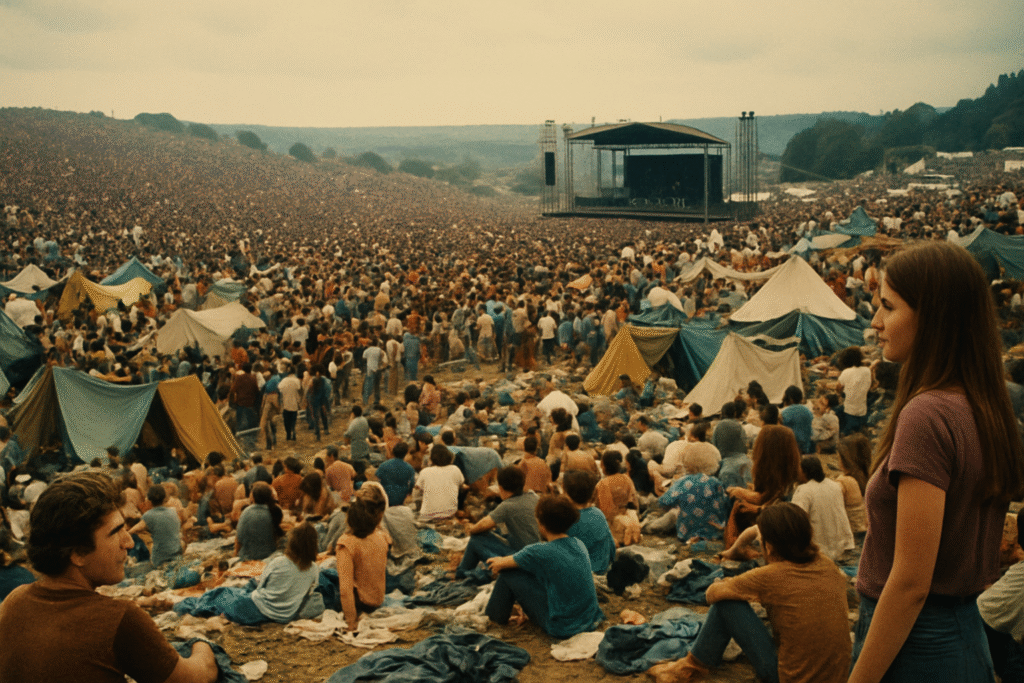
AI-generated image for illustrative purposes.
Woodstock brought together nearly 400,000 people on a farm in upstate New York. Three days of music, rain, mud, drugs, food shortages, and total logistical meltdown. If one were to describe the festival by those facts alone, it would sound like a disaster. But what endured wasn’t the disaster — it was the myth.
The collective memory chose to preserve images of young people embracing in the mud, bodies dancing in the rain, artists surrendering to intense performances. Chaos turned into poetry; disorder became a symbol of freedom. Woodstock stopped being just an event and became the embodiment of a utopia.
The Inevitable Mythmaking
The reality in Bethel was harsh: endless bathroom lines, health scares, overdoses, endless delays. But the popular imagination clung to the romantic version: the “Woodstock Nation,” a temporary community where peace and love seemed possible.
Much of that is thanks to the official 1970 documentary, which immortalized iconic moments like Richie Havens’ Freedom, Santana’s frenzied solo, Sly Stone’s mantra, and Hendrix’s distorted anthem. The cameras showed less mud and more of the dream.
And maybe that was exactly what that generation needed: a myth to believe another world was possible.
The Immediate Impact
For the music industry, Woodstock was a turning point. Before it, festivals were seen as risky, small-scale experiments. After Woodstock, no one doubted the power of gathering massive crowds around rock.
Artists who were already big — Hendrix, Janis Joplin, The Who — achieved legendary status. Others, like Santana and Joe Cocker, were catapulted into the global spotlight there. The industry realized festivals weren’t just cultural celebrations; they were multimillion-dollar business.
The Legacy for Future Generations
Woodstock wasn’t just about 1969. It became the benchmark for everything that followed. Every festival, from Glastonbury to Lollapalooza, carries a trace of its spirit. The very idea that music could unite thousands of people into something larger than the sum of its parts was born in Bethel.
Attempts to recreate the festival came later — in 1994, in 1999, even a planned 2019 edition that collapsed before happening. But none could capture the blend of innocence and urgency of the original. Without the counterculture, without the urgency of Vietnam, without the shock of the first time, every copy felt like a hollow caricature.
Woodstock as Cultural Myth
More than a festival, Woodstock is a metaphor. For some, it was the peak of the hippie movement; for others, its beginning of the end. For all, it proved that music can transform and define an era.
Romanticizing is inevitable. Yes, there was chaos. Yes, there was tragedy. But in collective memory, Woodstock endures as a utopia made real for three days — proof that even amid the mud, beauty could exist.
The Last Chord
When Hendrix twisted the national anthem that Monday morning, he didn’t just close Woodstock — he closed a decade. The hippie dream was already showing cracks, and the future would be less innocent. But for three days, nearly 400,000 young people believed peace and music could answer the world’s chaos.
Woodstock wasn’t perfect. But it’s that very imperfection that makes it timeless.
Burning Questions
Was Woodstock truly a peaceful event?
Despite the chaos, yes. There were remarkably few violent incidents. For its scale, it was surprisingly peaceful.
Why did attempts to recreate Woodstock fail?
Because it wasn’t just about music — it was about historical context. Without Vietnam, without the hippie movement, without that spirit of the times, no replica could have the same impact.
Is Woodstock overrated?
Technically, perhaps. Culturally, no. Few events in music history carry such symbolic weight.
What’s the festival’s greatest legacy?
The idea that music and culture can merge into a transformative collective experience — an ideal that still inspires festivals today.
— Lena Blaze, Rock Vaults
